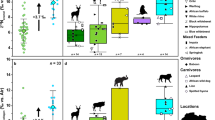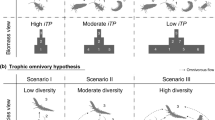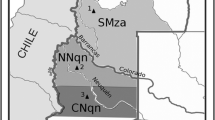Abstract
Recent studies have demonstrated that there exists significant variability in amino acid (AA) δ15N values of terrestrial plants, discriminating among plant types (i.e., legume seeds, grasses, tree leaves) as well as tissues of the same plant. For the first time, we investigate the potential of the spacing between the δ15N values of different AAs to differentiate between plant types and thus elucidate their relative importance in herbivore diet. Using principal component analysis, we show that it is possible to distinguish among five plant categories—cereal grains, rachis, legume seeds, herbaceous plants, and woody plants—whose consumption has different implications for understanding herbivore ecology and management practices. Furthermore, we were able to correctly classify the herbaceous plant diet of modern cattle using AA δ15N values of their tooth dentine adjusted for trophic enrichment. The AA δ15N patterns of wild and domestic herbivores from archaeological sites seem to be consistent with diets comprised predominantly of herbaceous plants, but there is variation in AA δ15N values among individuals that may reflect differing inputs of other plant types. The variation in AA δ15N values does not necessarily reflect the variation in herbivore bulk collagen δ13C and δ15N values, indicating that AA δ15N values have the potential to provide additional insights into plant dietary sources compared to bulk tissue isotope values alone. Future work should focus on defining trophic enrichment factors for a wider range of terrestrial herbivores and expanding libraries of primary producer AA δ15N values.





Similar content being viewed by others
Availability of data and materials
All source data are provided in supplementary information.
References
Bogaard A, Heaton THE, Poulton P, Merbach I (2007) The impact of manuring on nitrogen isotope ratios in cereals: archaeological implications for reconstruction of diet and crop management practices. J Archaeol Sci 34:335–343
Bonafini M, Pellegrini M, Ditchfield P, Pollard AM (2013) Investigation of the ‘canopy effect’ in the isotope ecology of temperate woodlands. J Archaeol Sci 40:3926–3935
Chikaraishi Y, Ogawa NO, Kashiyama Y, Takano Y, Suga H, Tomitani A, Miyashita H, Kitazato H, Ohkouchi N (2009) Determination of aquatic food-web structure based on compound-specific nitrogen isotopic composition of amino acids. Limnol Oceanogr Methods 7:740–750
Chikaraishi Y, Ogawa NO, Ohkouchi N (2010) Further evaluation of the trophic level estimation based on nitrogen isotopic composition of amino acids. In: Naohiko O, Ichiro T, Koba K (eds) Earth, life and isotopes, vol 415. Kyoto University Press, Kyoto, pp 37–51
Chikaraishi Y, Steffan SA, Ogawa NO, Ishikawa NF, Sasaki Y, Tsuchiya M, Ohkouchi N (2014) High-resolution food webs based on nitrogen isotopic composition of amino acids. Ecol Evol 4:2423–2449
Craine JM, Elmore AJ, Aidar MP, Bustamante M, Dawson TE, Hobbie EA, Kahmen A, Mack MC, McLauchlan KK, Michelsen A (2009) Global patterns of foliar nitrogen isotopes and their relationships with climate, mycorrhizal fungi, foliar nutrient concentrations, and nitrogen availability. New Phytol 183:980–992
de Zwart FJ, Slow S, Payne RJ, Lever M, George PM, Gerrard JA, Chambers ST (2003) Glycine betaine and glycine betaine analogues in common foods. Food Chem 83:197–204
Forde BG, Lea PJ (2007) Glutamate in plants: metabolism, regulation, and signalling. J Exp Bot 58:2339–2358
Fraser R, Bogaard A, Schäfer M, Arbogast R, Heaton THE (2013) Integrating botanical faunal and human stable carbon and nitrogen isotope values to reconstruct land use and palaeodiet at LBK Vaihingen an der Enz Baden-Württemberg. World Archaeol 45:492–517
Goodpaster AM, Kennedy MA (2011) Quantification and statistical significance analysis of group separation in NMR-based metabonomics studies. Chemometrics Intellig Lab Syst 109:162–170
Hagelstein P, Sieve B, Klein M, Jans H, Schultz G (1997) Leucine synthesis in chloroplasts: Leucine/isoleucine aminotransferase and valine aminotransferase are different enzymes in spinach chloroplasts. J Plant Physiol 150:23–30
Hamilton J, Hedges RE, Robinson M (2009) Rooting for pigfruit: pig feeding in Neolithic and Iron Age Britain compared. Antiquity 83:998–1011
Handley LL, Austin AT, Stewart GR, Robinson D, Scrimgeour CM, Raven JA, Heaton THE, Schmidt S (1999) The 15N natural abundance (δ15N) of ecosystem samples reflects measures of water availability. Funct Plant Biol 26:185–199
Hanson AD, Roje S (2001) One-Carbon metabolism in higher plants. Annu Rev Plant Physiol Plant Mol Biol 52:119–137
Hare P, Fogel ML, Stafford TW, Mitchell AD, Hoering TC (1991) The isotopic composition of carbon and nitrogen in individual amino acids isolated from modern and fossil proteins. J Archaeol Sci 18:277–292
Itahashi Y, Erdal YS, Tekin H, Omar L, Miyake Y, Chikaraishi Y, Ohkouchi N, Yoneda M (2019) Amino acid 15N analysis reveals change in the importance of freshwater resources between the hunter-gatherer and farmer in the Neolithic upper Tigris. Am J Phys Anthropol 168:676–686
Jolliffe IT (2002) Principal component analysis, 2nd edn. Springer, New York
Joshi V, Laubengayer KM, Schauer N, Fernie AR, Jander G (2006) Two Arabidopsis threonine aldolases are nonredundant and compete with threonine deaminase for a common substrate pool. Plant Cell 18:3564
Kendall IP, Lee MRF, Evershed RP (2017) The effect of trophic level on individual amino acid δ15N values in a terrestrial ruminant food web. STAR: Sci Technol Archaeol Res 3:135–145
Kendall IP, Woodward P, Clark JP, Styring AK, Hanna JV, Evershed RP (2019) Compound-specific δ15N values express differences in amino acid metabolism in plants of varying lignin content. Phytochemistry 161:130–138
Larsen T, Taylor DL, Leigh MB, O’Brien DM (2009) Stable isotope fingerprinting: a novel method for identifying plant, fungal, or bacterial origins of amino acids. Ecology 90:3526–3535
Larsen T, Ventura M, Andersen N, O’Brien DM, Piatkowski U, McCarthy MD (2013) tracing carbon sources through aquatic and terrestrial food webs using amino acid stable isotope fingerprinting. PLoS ONE 8:e73441
Lübcker N, Whiteman JP, Millar RP, de Bruyn PJN, Newsome SD (2020) Fasting affects amino acid nitrogen isotope values: a new tool for identifying nitrogen balance of free-ranging mammals. Oecologia 193:53–65
Makarewicz CA (2014) Winter pasturing practices and variable fodder provisioning detected in nitrogen (δ15N) and carbon (δ13C) isotopes in sheep dentinal collagen. J Archaeol Sci 41:502–510
McCarthy MD, Lehman J, Kudela R (2013) Compound-specific amino acid δ15N patterns in marine algae: Tracer potential for cyanobacterial vs. eukaryotic organic nitrogen sources in the ocean. Geochim Cosmochim Acta 103:104–120
McMahon KW, McCarthy MD (2016) Embracing variability in amino acid δ15N fractionation: mechanisms, implications, and applications for trophic ecology. Ecosphere 7:e01511
McMahon KW, Fogel ML, Elsdon TS, Thorrold SR (2010) Carbon isotope fractionation of amino acids in fish muscle reflects biosynthesis and isotopic routing from dietary protein. J Anim Ecol 79:1132–1141
Miflin B, Lea P (1977) Amino acid metabolism. Annu Rev Plant Physiol 28:299–329
Naito YI, Honch NV, Chikaraishi Y, Ohkouchi N, Yoneda M (2010) Quantitative evaluation of marine protein contribution in ancient diets based on nitrogen isotope ratios of individual amino acids in bone collagen: an investigation at the Kitakogane Jomon site. Am J Phys Anthropol 143:31–40
Nielsen JM, Popp BN, Winder M (2015) Meta-analysis of amino acid stable nitrogen isotope ratios for estimating trophic position in marine organisms. Oecologia 178:631–642
Papachristou TG, Dziba LE, Provenza FD (2005) Foraging ecology of goats and sheep on wooded rangelands. Small Rumin Res 59:141–156
Pearson JA, Buitenhuis H, Hedges RE, Martin L, Russell N, Twiss KC (2007) New light on early caprine herding strategies from isotope analysis: a case study from Neolithic Anatolia. J Archaeol Sci 34:2170–2179
Pearson J, Lamb A, Jane E (2021) Multi-isotope evidence of diet (carbon and nitrogen) and mobility (strontium) at Neolithic Çatalhöyük. In: Hodder I (ed) Peopling the landscape of Çatalhöyük: reports from the 2009–2017 seasons, vol 53. British Institute at Ankara, pp 217–244
Pedregosa F, Varoquaux G, Gramfort A, Michel V, Thirion B, Grisel O, Blondel M, Prettenhofer P, Weiss R, Dubourg V, Vanderplas J, Passos A, Cournapeau D, Brucher M, Perrot M, Duchesnay E (2011) Scikit-learn: machine learning in python. J Mach Learn Res 12:2825–2830
Popp BN, Graham BS, Olson RJ, Hannides CCS, Lott MJ, López-Ibarra GA, Galván-Magaña F, Fry B (2007) Insight into the trophic ecology of Yellowfin Tuna, Thunnus albacares, from compound-specific nitrogen isotope analysis of proteinaceous amino acids. Terrestrial ecology, vol 1. Elsevier, Amsterdam, pp 173–190
Prell J, White JP, Bourdes A, Bunnewell S, Bongaerts RJ, Poole PS (2009) Legumes regulate Rhizobium bacteroid development and persistence by the supply of branched-chain amino acids. Proc Natl Acad Sci 106:12477–12482
Ramirez MD, Besser AC, Newsome SD, McMahon KW (2021) Meta-analysis of primary producer amino acid δ15N values and their influence on trophic position estimation. Methods Ecol Evol 12:1750–1767
Steffan SA, Chikaraishi Y, Horton DR, Ohkouchi N, Singleton ME, Miliczky E, Hogg DB, Jones VP (2013) Trophic hierarchies illuminated via amino acid isotopic analysis. PLoS ONE 8:e76152
Styring AK, Fraser RA, Bogaard A, Evershed RP (2014a) Cereal grain, rachis and pulse seed amino acid δ15N values as indicators of plant nitrogen metabolism. Phytochemistry 97:20–29
Styring AK, Fraser RA, Bogaard A, Evershed RP (2014b) The effect of manuring on cereal and pulse amino acid δ15N values. Phytochemistry 102:40–45
Styring AK, Fraser RA, Arbogast R-M, Halstead P, Isaakidou V, Pearson JA, Schäfer M, Triantaphyllou S, Valamoti SM, Wallace M, Bogaard A, Evershed RP (2015) Refining human palaeodietary reconstruction using amino acid δ15N values of plants, animals and humans. J Archaeol Sci 53:504–515
Vaiglova P, Halstead P, Pappa M, Triantaphyllou S, Valamoti SM, Evans J, Fraser R, Karkanas P, Kay A, Lee-Thorp J, Bogaard A (2018) Of cattle and feasts: Multi-isotope investigation of animal husbandry and communal feasting at Neolithic Makriyalos, northern Greece. PLoS ONE 13:e0194474
van Groenigen J-W, van Kessel C (2002) Salinity-induced patterns of natural abundance carbon-13 and nitrogen-15 in plant and soil. Soil Sci Soc Am J 66:489–498
Ventresca Miller AR, Bragina TM, Abil YA, Rulyova MM, Makarewicz CA (2019) Pasture usage by ancient pastoralists in the northern Kazakh steppe informed by carbon and nitrogen isoscapes of contemporary floral biomes. Archaeol Anthropol Sci 11:2151–2166
Acknowledgements
We thank Rothamsted Research and the Lawes Trust for access to the archived Rothamsted crop samples. We also thank Ines Merbach for sample collection from the Bad Lauchstädt Experimental Research Station, and the late Robert Orr for assistance with sample collection from the North Wyke Farm Platform, a UK National Capability supported by the Biotechnology and Biological Sciences Research Council (BBSRC BB/J004308/1). We are very grateful to three anonymous reviewers whose careful comments have greatly improved this manuscript.
Funding
The AA δ15N values of modern crops and archaeological herbivore bone collagen were determined whilst AKS was in receipt of a NERC studentship (RE2158) that formed part of a NERC Standard Grant NE/E003761/1 (PI AB). The AA δ15N values of modern herbaceous and woody plants and cattle bone collagen were determined whilst IK was funded by the European Research Council (ERC) Advanced Grant NeoMilk (FP7-IDEAS-ERC/324202, to RPE). NERC (Reference: CC010) and NEIF (www.isotopesuk.org) are thanked for funding and maintenance of the GC-C-IRMS instruments used for this work.
Author information
Authors and Affiliations
Contributions
AKS designed the study and provided unpublished data, MHYC analyzed the data and designed the statistical framework, IPK provided additional unpublished data. MHYC wrote the manuscript with AKS and input from all authors.
Corresponding authors
Ethics declarations
Conflict of interest
The authors declare that they have no conflict of interest.
Ethical approval
For this type of study, formal consent is not required.
Additional information
Communicated by Seth Newsome.
Multivariate statistics show that patterns in amino acid nitrogen isotope values have the potential to differentiate between plant types and elucidate their contribution to herbivore diet.
Supplementary Information
Below is the link to the electronic supplementary material.
Rights and permissions
Springer Nature or its licensor (e.g. a society or other partner) holds exclusive rights to this article under a publishing agreement with the author(s) or other rightsholder(s); author self-archiving of the accepted manuscript version of this article is solely governed by the terms of such publishing agreement and applicable law.
About this article
Cite this article
Chen, M.H.Y., Kendall, I.P., Evershed, R.P. et al. Reconstructing herbivore diets: a multivariate statistical approach to interpreting amino acid nitrogen isotope values. Oecologia 201, 599–608 (2023). https://doi.org/10.1007/s00442-023-05320-1
Received:
Accepted:
Published:
Issue Date:
DOI: https://doi.org/10.1007/s00442-023-05320-1




